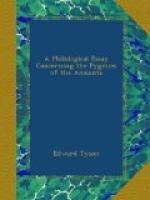[Footnote A: Grimm ap. Keightley, p. 261.]
[Footnote B: Villemarque, ibid., 431.]
[Footnote C: Tregear, ut supra.]
[Footnote D: Journ. Anthrop. Inst., xx. 124.]
Dr. Nansen, speaking of the Ignerssuit (plural of Ignersuak, which means “great fire"), says that they are for the most part good spirits, inclined to help men. The entrance to their dwellings is on the sea-shore. According to the Eskimo legend, “The first earth which came into existence had neither seas nor mountains, but was quite smooth. When the One above was displeased with the people upon it, He destroyed the world. It burst open, and the people fell down into the rifts and became Ignerssuit and the water poured over everything."[A] The spirits here alluded to appear to be the same as those described by Mr. Boas as Uissuit in his monograph on the Central Eskimo. He describes them as “a strange people that live in the sea. They are dwarfs, and are frequently seen between Iglulik and Netchillik, where the Anganidjen live, an Innuit tribe whose women are in the habit of tracing rings around their eyes. There are men and women among the Uissuit, and they live in deep water, never coming to the surface. When the Innuit wish to see them, they go in their boats to a place where they cannot see the bottom, and try to catch them with hooks which they slowly move up and down. As soon as they get a bite they draw in the line. The Uissuit are thus drawn up; but no sooner do they approach the surface than they dive down headlong again, only their legs having emerged from the water. The Innuit have never succeeded in getting one out of the water."[A]
[Footnote A: Nansen, ut supra, p. 259.]
[Footnote A: American Bureau of Ethnology, vi. 612.]
8. Amongst habitations not coming under any of the above categories may be mentioned the moors and open places affected by the Cornish fairies, and lastly the curious residences of the Kirkonwaki or Church-folk of the Finns. “It is an article of faith with the Finns that there dwell under the altar in every church little misshapen beings which they call Kirkonwaki, i.e., Church-folk. When the wives of these little people have a difficult labour, they are relieved if a Christian woman visits them and lays her hand upon them. Such service is always rewarded by a gift of gold and silver."[A] These folk evidently correspond to the Kirkgrims of Scandinavian countries, and the traditions respecting both are probably referable to the practice of foundation sacrifices.
[Footnote A: Grimm ap. Keightley, p. 488.]




